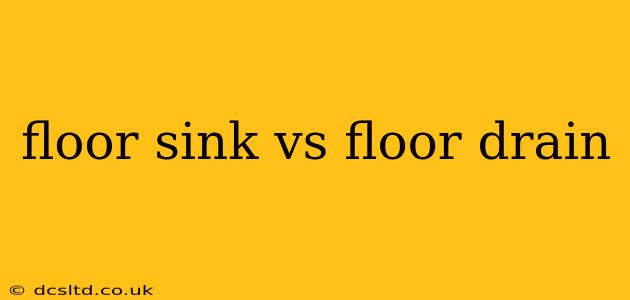Choosing between a floor sink and a floor drain often depends on the specific needs of your space and the intended use. While both serve the purpose of draining water from the floor, their design, function, and applications differ significantly. This comprehensive guide will clarify the distinctions between floor sinks and floor drains, helping you make an informed decision.
What is a Floor Sink?
A floor sink, also known as a floor drain with a receptor, is a recessed drainage system featuring a visible, usually stainless steel, basin or receptor. This basin collects water before it drains into the plumbing system. They are often found in commercial kitchens, industrial settings, and some high-end residential bathrooms. The noticeable basin makes cleaning easier as debris and grime are contained within the receptor.
Advantages of a Floor Sink:
- Easy Cleaning: The visible basin allows for easy cleaning and maintenance, preventing clogs and ensuring hygiene.
- Debris Collection: The receptor effectively traps larger debris, protecting the drainpipe system from blockages.
- Aesthetic Appeal (in some cases): Certain floor sink designs can be aesthetically pleasing, particularly in upscale settings.
Disadvantages of a Floor Sink:
- Higher Cost: Floor sinks typically cost more than simple floor drains due to the additional basin and construction.
- More Space Required: The recessed basin requires more space than a standard floor drain.
- Potential for Water Splashing: Depending on the design and water pressure, splashing might occur.
What is a Floor Drain?
A floor drain is a simple drainage opening set into the floor, typically covered by a grate. It's designed for quick drainage of water, often used in shower stalls, garages, basements, and other areas prone to water accumulation. The lack of a visible basin means debris can potentially pass into the drainpipe, potentially leading to clogs if not maintained regularly.
Advantages of a Floor Drain:
- Lower Cost: Floor drains are generally less expensive than floor sinks.
- Space-Saving: They require minimal space and can be easily integrated into various floor designs.
- Simple Installation: Installation is usually simpler and quicker compared to floor sinks.
Disadvantages of a Floor Drain:
- Increased Risk of Clogs: Without a basin to collect debris, there's a higher chance of clogs forming in the drainpipe.
- Difficult Cleaning: Cleaning can be challenging as debris might settle directly in the drainpipe.
- Less Hygienic (potentially): The lack of a visible basin can make cleaning and maintaining hygiene more difficult.
Floor Sink vs. Floor Drain: Which One Should You Choose?
The best choice depends on your specific needs and the environment.
-
Choose a floor sink if: You need a system that is easy to clean, effectively traps debris, and prioritizes hygiene (e.g., commercial kitchens, high-traffic areas).
-
Choose a floor drain if: You need a cost-effective, space-saving solution for areas with less intense water use and debris (e.g., showers, basements, garages).
What are the different types of floor drains?
Floor drains come in a variety of types, each designed for specific applications and drainage needs. These include weirs, strainers, and others. Choosing the correct type depends greatly on factors like the anticipated water flow, the presence of potential debris, and the overall plumbing setup. Consulting with a plumbing professional is always recommended to select the best drain type for your situation.
What is the best way to clean a floor drain?
Regular cleaning is crucial for both floor sinks and floor drains to prevent clogs and ensure proper drainage. For floor sinks, simply wipe down the basin regularly. For floor drains, use a drain cleaning tool or a mixture of baking soda and vinegar to clear any blockages. However, persistent clogs may require professional intervention.
How do I prevent clogs in floor drains?
Preventing clogs involves regular cleaning and careful consideration of what materials go down the drain. Avoiding pouring grease, hair, or other debris down the drain will significantly reduce the risk of clogging. Regular use of drain cleaning products or preventative treatments can also help maintain optimal drain function.
How much does a floor drain cost?
The cost of a floor drain varies based on material, size, and features. A simple drain might cost only a few dollars, while more complex models can cost significantly more. Installation costs should also be considered when budgeting for a new floor drain. Professional installation is often recommended to ensure correct installation and long-term performance.
